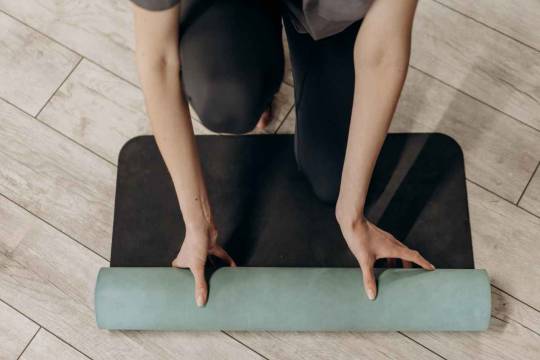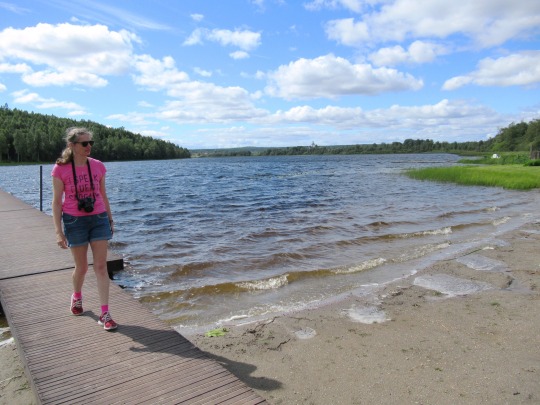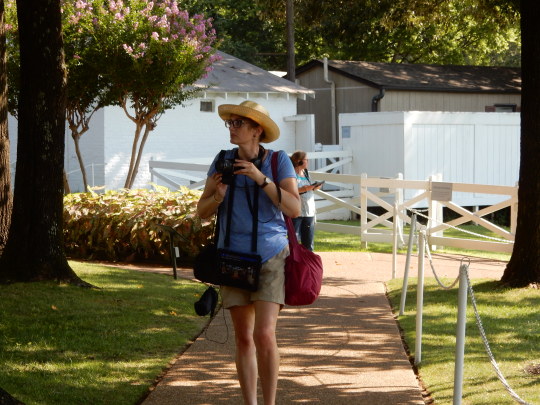#what are the benefits of aerobic exercise
Explore tagged Tumblr posts
Text
The Chief Benefits of Anaerobic Exercise
Anaerobic exercise, also known as high-intensity interval training (HIIT), is any type of exercise that is done at or above 85% of your maximum heart rate for short periods of time. This type of exercise is beneficial for a number of reasons, but the chief benefit is its ability to build muscle.Anaerobic exercise is any type of exercise that is performed without oxygen. This means that the body…

View On WordPress
#Anaerobic Exercise#what are some benefits of regular exercise on psychological well-being#what are the benefits of aerobic exercise#what are the benefits of anaerobic exercise#what are the benefits of kegel exercises#what is one benefit of starting an exercise program slowly
1 note
·
View note
Text
Also preserved in our archive
Listen at the first link!
The GIST
Recent studies suggest that a hypermetabolic state that damages the mitochondria results in a hypometabolic state in chronic fatigue syndrome (ME/CFS), long COVID, and fibromyalgia (FM). They also suggest that something in the blood, serum, or plasma is damaging the mitochondria in these diseases.
We’re not done with the mitochondria, though – far from it! Now we look at a bevy of recent long-COVID mitochondrial studies suggesting that mitochondrial dysfunction affects more than energy production and which illuminate what may have gone wrong in the mitochondria.
Muscle biopsies of 120 long-COVID patients who had ended up in the ICU found that a year later their muscles had higher levels of immune cells involved in tissue repair and reduced activity of the 2nd and fourth mitochondrial complexes. The authors concluded that there was “aberrant repair and altered mitochondrial activity in skeletal muscle.”
They couldn’t explain how a respiratory illness affected the muscles but a subsequent study did. A hamster model found that the coronavirus suppressed the genes associated with the muscle fibers, protein production, both sides of the mitochondrial energy production process (Krebs cycle and electron transport chain), and fat breakdown.
As it was doing that, it unleashed a barrage of inflammatory factors (IFN-α, IFN-γ, and TNF-α) which triggered a shift from relying mostly on aerobic energy production to the less effective process of anaerobic energy production (glycolysis).
The authors concluded that using treatments “that can boost mitochondrial functions, enhance protein synthesis, and inhibit protein degradation” may be useful for treating muscle fatigue in long COVID.
Next, a muscle study assessing “maximal fatty acid oxidation (MFO)” (i.e. energy produced by the breakdown of fats during exercise) found significantly reduced levels of fatty acid oxidation in long COVID and a “premature shift” from relying on fats to carbohydrates to powering their cells.
This was important because the body prefers to burn fats during exercise and because fats play key roles in both parts of the mitochondrial energy production process. The finding wasn’t so surprising, though. Problems with carnitine – which transports fatty acids into the mitochondria – have popped up in both long COVID and ME/CFS – suggesting that the fatty acids that power the mitochondria during exercise may not be getting into them.
A review paper asserted that increased free radical production (reactive oxygen species (ROS)) by the mitochondria both pushes the cell into a state of anaerobic energy production but also pushes the immune system to activate the inflammatory or innate immune response and away from the adaptive immune response that targets pathogens. This benefits the viruses by providing the substrates they need to grow and allows them to escape from the immune system.
Several researchers, including Avindra Nath, believe that the immune system tries to compensate for the impaired adaptive immune defense by ramping up the innate immune response. Nath believes this shift plays a central role in ME/CFS.
They proposed that treatments to boost mitochondrial functioning and reduce the production of mitochondrial reactive oxygen species (ROS) (free radicals) will be beneficial.
Lastly, a review asserted that the predominant view of the mitochondria as the main energy producers of the cell is misguided and incomplete. Harkening back to Naviaux’s characterization of the mitochondria as the primary threat-sensing part of the cell, the authors believe the mitochondria regulate the “physiological processes at the level of the cell, organ and organism”; i.e. the mitochondrial problems affect much more than low energy levels and fatigue.
A blog on red light/infrared light therapy – which could both boost mitochondrial health and antioxidant defenses – is coming up.
Full text at either link! There's a lot more than the gist
#long covid#covid is airborne#pandemic#mask up#covid#wear a mask#public health#covid 19#wear a respirator#still coviding#coronavirus#sars cov 2
92 notes
·
View notes
Text
HIIT Workout: Should I Start with HIIT or Cardio?
HIIT vs. Cardio: Which Is Right for You?
When it comes to achieving fitness goals, many people find themselves debating between High-Intensity Interval Training (HIIT) and steady-state cardio. Both forms of exercise offer unique benefits, but which one is better depends on your goals, fitness level, and preferences. This article will explore the differences, benefits, and when to choose each method to help you decide.
What is HIIT?
High-Intensity Interval Training (HIIT) involves alternating short bursts of intense exercise with brief periods of rest or low-intensity activity. For example, you might sprint for 30 seconds, then walk for 60 seconds, repeating this cycle for 20-30 minutes.
Benefits of HIIT:
Time-Efficient: HIIT delivers significant results in less time compared to steady cardio.
Boosts Metabolism: It elevates your metabolic rate for hours after a workout, promoting fat burning.
Preserves Muscle Mass: HIIT primarily targets fat while maintaining lean muscle tissue.
Improves Cardiovascular Fitness: It increases both anaerobic and aerobic endurance.
Citation: A 2011 study in the Journal of Obesity found that HIIT is highly effective in reducing abdominal fat and improving overall cardiovascular health.
What is Cardio?
Steady-state cardio involves maintaining a consistent pace and intensity for a prolonged period, such as jogging, cycling, or swimming. Sessions typically last 30-60 minutes and keep your heart rate at a moderate level.
Benefits of Cardio:
Improves Endurance: It's ideal for building long-term stamina and aerobic capacity.
Supports Heart Health: Cardio strengthens the heart, reducing the risk of cardiovascular diseases.
Burns Calories: While not as intense as HIIT, cardio is effective for weight management.
Stress Relief: It can lower stress and improve mental health through steady, rhythmic activity.
Citation: According to the American Heart Association, steady-state cardio reduces the risk of heart disease and improves overall cardiovascular function.
HIIT vs. Cardio: A Comparison
Feature HIIT Cardio Time Commitment Short (15-30 minutes) Longer (30-60 minutes) Calorie Burn Higher in less time Lower but steady Fat Loss Highly effective, especially post-workout Effective over time Muscle Preservation Preserves lean muscle May lead to muscle loss with excessive duration Fitness Level Intermediate to advanced Beginner-friendly Impact on Joints High impact, can strain joints Lower impact, joint-friendly options available
Which is Better for Your Goals?
Weight Loss:
HIIT is more efficient for burning calories and boosting metabolism, especially if you’re short on time. However, combining both methods can offer sustained fat loss.
Improving Stamina:
Cardio is better suited for building endurance and improving aerobic capacity over time.
Building Muscle:
HIIT preserves and may even help build muscle due to its high-intensity nature, whereas excessive cardio might lead to muscle loss.
Overall Health:
Both forms are beneficial for cardiovascular health, but cardio is generally more accessible and less stressful for beginners or those with joint concerns.
When to Choose HIIT or Cardio
Choose HIIT if:
You’re short on time.
You want to burn fat quickly.
You’re looking to improve strength and power.
Choose Cardio if:
You prefer a low-intensity, steady workout.
You’re training for endurance events like a marathon.
You’re a beginner or have joint issues.
Can You Combine HIIT and Cardio?
Absolutely! Incorporating both methods into your routine provides variety and balances endurance with strength. For example:
Do 2-3 HIIT sessions per week for fat-burning and metabolic benefits.
Include 1-2 steady-state cardio sessions for endurance and recovery.
Conclusion
HIIT and cardio both have their place in a well-rounded fitness program. HIIT is excellent for those seeking quick, efficient results, while steady-state cardio offers endurance and long-term health benefits. Understanding your goals, fitness level, and preferences will help you choose the best approach—or combine the two for optimal results.
References:
Journal of Obesity, 2011 – Benefits of High-Intensity Interval Training.
American Heart Association – Cardiovascular benefits of steady-state cardio.
Medicine & Science in Sports & Exercise, 2015 – Comparing calorie burn between HIIT and cardio.
#Should I Start with HIIT or Cardio?#cardio hiit#hiit exercise#hiitworkout#HIIT#video#exercise#workout#fitness motivation#youtube#tumblr#core workout
12 notes
·
View notes
Text

By: Colin Wright
Published: Jul 3, 2025
On Tuesday, the University of Pennsylvania reached an agreement with the Trump administration’s Department of Education regarding trans-identified male swimmer Lia Thomas’s participation on the women’s swim team. Following a federal investigation, the university has agreed to revise records set by Thomas and to restore titles and accolades to the female athletes he displaced. UPenn will also issue personal apologies to the affected swimmers, bar male athletes from competing in women’s sports, and adopt biology-based definitions of “male” and “female” under Title IX.
This correction was inevitable. Reality, in the end, reasserts itself. But the mainstream press hasn’t budged. Instead, they continue to misinform their readers, deploying headlines designed to obscure plain facts.
Consider a representative sample of mainstream media headlines. The New York Times claimed that Penn had agreed “to Limit Participation of Transgender Athletes.” The Washington Post reported that the school would “bar transgender athletes from women’s sports teams.” NBC News, USA Today, and BBC all referred to “ban[s]” on “trans athletes.”
These headlines aren’t just misleading; they’re false. Lia Thomas wasn’t barred from female sports for being “transgender”; he was barred for being a male. Any other male, whether he identified as transgender or not, would be barred for the same reason. Trans-identifying males remain fully eligible to compete in UPenn athletics—on the men’s team.
Instead of focusing on the women who benefit from the university’s course correction, the media has centered its attention on Thomas. Headlines have emphasized that Thomas was “stripped of titles,” but have largely overlooked the women whose titles were restored: Anna Kalandadze, Virginia Burns, and Kayla Fu, whose records in the 500-meter, 200-meter, and 100-meter freestyle, respectively, have now been reinstated.
Predictably, proponents for allowing males to compete in women’s sports have wasted no time distorting scientific evidence to denounce UPenn’s decision. Two CNN reporters, for instance, claimed that the idea “transgender athletes have an unfair advantage in sports” is “not what the research shows.” They pointed to a 2017 review, which claimed that there was “no direct and consistent research to suggest that [trans-identifying males] . . . have an athletic advantage in sport.” But that conclusion flowed largely from the lack of studies on the question—an issue driven less by uncertainty than by the assumption that the answer was self-evident. Since then, hard data have emerged confirming what anyone with functioning eyes already knew: that trans-identifying males’ use of testosterone-suppressing drugs and cross-sex hormones only moderately reduces, but comes nowhere close to eliminating, the performance gap between male and female athletes.
Later in that article, the CNN reporters cited a 2023 review claiming that many sex differences after puberty are “reduced, if not erased, over time by gender-affirming hormone therapy.” But this argument cherry-picks a narrow set of metrics—such as performance in certain bodyweight exercises and maximum aerobic capacity—while ignoring the primary drivers of male athletic advantage: muscle and tendon size, height, speed, and strength. These traits are either minimally affected or not affected at all by testosterone suppression.
This kind of selective framing and omission won’t serve the Left in the long run. Writing in The Bulwark, Jill Lawrence recently urged Democrats not to “dodge” or “avoid confrontation” on transgender issues but to “dominate this debate.” Notably, she sidestepped the question of fairness entirely, arguing instead that trans-identified males should be allowed to compete in women’s sports to reduce their “depression, anxiety, suicide attempts, and suicide.”
But the Left cannot continue to name “mental health benefits” as justification for allowing trans-identifying males in women’s sports, while knowing that the public overwhelmingly opposes it and often reacts with intense, sometimes vitriolic, backlash. If activists are genuinely concerned about these athletes’ mental health, the sounder advice would be to discourage them from competing in female categories.
More importantly, allowing men to compete in women’s sports harms the mental and physical well-being of the women forced to compete with them, share locker rooms, and lose hard-won opportunities. Their interests must come first. Even for Thomas, the outcome was not affirmation but humiliation—stripped titles and a damaged reputation—not because of bigotry, but because reality eventually caught up with the falsehoods.
Democrats are free to champion whatever causes they like, but the Trump administration’s intervention in the trans sports debate offers them a quiet off-ramp from an issue that has become a major electoral liability, even among their own voters. Letting the administration’s policy stand may be their best chance to shore up support ahead of 2028.
UPenn’s reversal is a meaningful win for reality, but the fight is far from over. The Left still yearns for the moral high of historic civil rights victories. With most of those battles already won, some progressives have resorted to manufacturing new ones as a way to signal their supposed virtue. But that strategy is becoming harder to sustain as these invented causes drift further from reality—and drive moderates away in the process.
[ Via: https://archive.today/0r8PB ]
#Colin Wright#William Thomas#Lia Thomas#propaganda#trans propaganda#women's sports#reality#human biology#biological dimorphism#University of Pennsylvania#religion is a mental illness
2 notes
·
View notes
Text
5BX: The Cold War Military Workout for Getting Fit in 11 Minutes a Day
In last month’s AoM podcast episode with Dr. Martin Gibala about high-intensity interval training, he mentioned a high-intensity workout program that was developed by the Royal Canadian Air Force during the late 1950s, took only eleven minutes to perform, and became hugely popular with the civilian population. Duly intrigued, we decided to dig up the program to see what it involved. The 5BX plan (Five Basic Exercises) was born out of a particular need: a third of the RCAF’s pilots were deemed unfit to fly and needed a workout program that 1) could be done without any specialized equipment, as the pilots were often stationed at remote bases without access to standard gyms, and 2) could fit into airmen’s busy schedules. While high-intensity training hadn’t yet won mainstream acceptance, the pioneering research of Dr. Bill Orban had showed that by increasing the intensity of exercise, people could get the same fitness-improving benefits in much less time. Orban used this insight to develop 5BX, which involved doing five exercises — four of which targeted flexibility and strength and one that worked aerobic capacity — in just eleven minutes. The Canadian military encouraged not only its pilots to perform it, but their children as well. Orban also developed a plan for women called XBX, which involved doing ten exercises in 12 minutes. In the 1960s, the programs were published together as the Royal Canadian Air Force Exercise Plans and distributed outside the military. The booklet became popular with civilians not only in Canada but around the world; it was translated into thirteen languages, sold 23 million copies, and is credited with helping to launch our modern fitness culture. If you’d like to try it out, we’ve reformatted and republished the 5BX plan below. It features six “charts,” each of which includes the program’s five main exercises: * Stretching * Sit-up * Back extension * Push-up * Running in place, interspersed with various jumps (can be substituted for an actual run or walk) Each chart offers progressively more difficult variations of the five exercises, and you work your way from one level of performance on a particular chart to the next, and then from one chart to the next. Charts 5 and 6 get into some elite-level athletics — good luck with those toe-touching jack jumps, friends. For a visual demonstration of some of the exercises, watch this 1959 Royal Canadian Air Force training video. --- The Five Basic Exercises (5BX) Plan presented in this booklet is designed to show you how to develop and hold a high level of physical fitness, regardless of where you may be located. The scheme is not dependent on elaborate facilities or equipment. The exercises require only eleven minutes a day and can be done in your bedroom or beside your bed in your barracks. The diversity of work assignments, combined with lack of adequate gymnasium facilities at many of your stations makes it difficult to schedule formal physical training periods for all our personnel. The 5BX Plan puts physical fitness training within reach of every member of the RCAF. It is your duty and responsibility as a member of the RCAF to maintain a high level of physical fitness and be ready for any emergency which may require the extended use of your physical resources. Positive physical well-being is also closely allied with mental and emotional fitness, all of which are essential in the discharge of normal daily tasks. Warming Up The 5BX Plan was designed so that no additional warmup is necessary in order to receive its maximum benefits. The older one is, the more necessary proper warming up becomes to avoid “strained” muscles. The 5BX Plan has a built-in method of warmup. This is achieved in two ways: * by the arrangement of the exercises; and * by the manner in which these exercises are performed. For example, the first exercise is a stretching and loosening exercise which limbers up the large muscles of the body. In addition, this exercise should be started very… http://dlvr.it/T4JMgd
13 notes
·
View notes
Text
WHAT'S IS A GOOD GYM ROUTINE FOR BEGINNERS?
There are a ton of simple fat-burning exercises available, especially for beginners. Whatever your fitness objectives, it is critical that you follow through on them and maintain consistency; otherwise, it is unlikely that you will see any noticeable changes.
If you’re looking for a simple gym routine that works and is easy to follow, why not consider the following workouts:
BURPEES (10-12 REPS)
Equipment: no equipment required
One of the best exercises you can do is a burpee. They don't require any special tools or training, but if you work hard enough, you will begin to notice the benefits. We advise warming up with some stretches and aerobics for a few minutes before you begin.
MOUNTAIN CLIMBERS (10-12 REPS)
Equipment: no equipment required
Mountain climbers train your balance, agility, and coordination while working a variety of muscle areas simultaneously. They will support the maintenance of your leg, core, back, and arm gains. Due to their intensity, they will undoubtedly raise your heart rate and burn a significant amount of calories.
DUMBBELL SQUAT PRESS (10-12 REPS)
Equipment: a dumbbell, kettlebell or weights plate
Squat exercises that use dumbbells are especially powerful. In general, squats are a great way to tone your lower body and target a variety of muscle groups, such as your hamstrings, glutes, and quadriceps. They are easily adaptable to suit all abilities and yield amazing results for your general fitness as well. A weight is held against the chest in this variation of the exercise to add resistance to the movement.
KETTLEBELL SWINGS (10-12 REPS)
Equipment: a kettlebell
Swinging a kettlebell is an excellent calorie-burning exercise. With this exercise, you might actually burn up to 400 calories in 20 minutes. Your aerobic capacity ought to benefit greatly from this intensity. Not to mention, kettlebell swings exercise practically every muscle in the body, including the shoulders, back, legs, and core.
Repeat this 2 to 5 times.
#Fitness#Health#gym#Workout#Exercise#FitnessGoals#GymLife#FitLife#Cardio#StrengthTraining#Yoga#Pilates#Running#FitFam#HealthyLiving#FitnessJourney#FitnessMotivation#Fitspo#Fitspiration#HealthyLifestyle#Sweat#TrainHard#NoPainNoGain#FitnessAddict#FitGirl#FitGuys#nutrition
6 notes
·
View notes
Text
HIIT vs. LISS: Choosing the Best Cardio for Your Fitness Goals When it comes to cardio workouts, two popular methods stand out: HIIT (High-Intensity Interval Training) and LISS (Low-Intensity Steady-State). Both are effective for improving heart health, burning calories, and achieving fitness goals, but they work in different ways. Choosing the right one depends on your objectives, fitness level, and preferences.
What is HIIT? HIIT involves short bursts of intense exercise followed by rest or low-intensity recovery. For example, sprinting for 30 seconds followed by a 30-second walk, repeated for 15-20 minutes. This type of workout pushes your heart rate to near-max levels, making it a powerful way to burn calories quickly.
Benefits of HIIT Time Efficiency: HIIT sessions typically last between 15-30 minutes. Perfect for those with a tight schedule. Calorie Burn: The high intensity of HIIT burns more calories in less time. Afterburn Effect: HIIT increases your metabolism for hours post-workout, thanks to Excess Post-Exercise Oxygen Consumption (EPOC). Muscle Preservation: Incorporating bodyweight or resistance exercises helps preserve or build muscle mass. Cardiovascular Fitness: Improves heart and lung capacity by challenging your cardiovascular system. What is LISS? LISS involves steady, moderate-paced cardio for a longer duration, typically 30-60 minutes. Activities like walking, swimming, or cycling at a pace where you can maintain a conversation fall into this category. LISS is low-impact, making it accessible to everyone, including beginners and those recovering from injuries.
Benefits of LISS Low Impact: Gentle on joints, ideal for recovery or individuals with joint pain. Endurance Building: Improves aerobic capacity over time, perfect for long-distance training. Sustainable: Easier to maintain as part of a long-term fitness routine. Fat Burning: During LISS, the body primarily uses fat for energy, aiding in gradual fat loss. Mental Health: The steady pace can reduce stress and offer a meditative experience. Which One Should You Choose? For Fat Loss: HIIT burns more calories in less time, making it effective for rapid fat loss. However, combining HIIT with LISS can yield sustainable results. For Endurance: If you’re training for long-distance events, LISS helps build stamina and aerobic capacity. For Busy Schedules: HIIT's shorter sessions are perfect for those who need an efficient workout. For Low-Impact Exercise: LISS is better if you prefer gentler workouts or are recovering from an injury. Combining HIIT and LISS A balanced workout plan can incorporate both HIIT and LISS for maximum benefits. For example, do 2-3 HIIT sessions and 2 LISS sessions per week. This combination boosts fat loss, enhances endurance, and minimizes the risk of burnout or injury.
Ultimately, the best cardio is the one that fits your goals, lifestyle, and preferences. Whether you prefer the intensity of HIIT or the steady pace of LISS, staying consistent is key to achieving your fitness goals.
For more in-depth insights, visit
#health#health & fitness#health and wellness#health insurance#health tips#healthcare#healthy diet#healthy eating#healthy food#healthy girl
2 notes
·
View notes
Text
Cardio Tennis: A Comprehensive Fitness Experience
Cardio Tennis is revolutionising the way people approach both fitness and tennis, merging high-energy workouts with the sport's fundamentals in a fun and social environment. Whether you’re a seasoned athlete or just looking to try something new, Cardio Tennis offers a unique blend of exercise and sport, ensuring participants reap numerous benefits.

What is Cardio Tennis?
Cardio Tennis is a group fitness class that combines tennis drills and games with cardiovascular exercise, all set to lively, upbeat music. The primary focus is on getting your heart rate up and burning calories while engaging in tennis-related activities. Unlike traditional tennis lessons, Cardio Tennis emphasises constant movement and a non-stop workout experience, making it an effective and enjoyable way to improve your fitness and tennis skills simultaneously.
Former professional tennis coach George Thomas from TennisHQ say, “Cardio tennis has always been a joy to teach because it draws a diverse group of participants, each at different stages in their tennis and fitness journeys. The beauty of cardio tennis is that it benefits everyone equally, regardless of their skill or fitness level. Many attendees forget they're even in a fitness class because it's so fun and adaptable to any challenge level. With hundreds of different drills, no session is ever the same, and coaches are always looking for new elements to keep the classes fresh and engaging.”
Fitness Benefits
From a fitness perspective, Cardio Tennis offers numerous advantages:
Calorie Burning: Engaging in Cardio Tennis can help you burn up to 600 calories per hour. The continuous movement and high-intensity drills ensure you get a thorough cardiovascular workout.
Improved Cardiovascular Health: The aerobic nature of the class helps strengthen your heart and lungs, improving your overall cardiovascular endurance.
Enhanced Agility and Coordination: Tennis-specific drills enhance your agility, coordination, and reaction time, providing a full-body workout.
Self-Paced Intensity: Participants can adjust the intensity of their workout, pushing themselves as hard as they feel comfortable. This self-paced approach makes it accessible to all fitness levels.
Motivational Music: Upbeat and energetic music keeps participants motivated, making the workout feel more like a dance party than a traditional exercise session.
Tennis Benefits
For those interested in tennis, Cardio Tennis offers a perfect entry point:
Good Way to Get Into Tennis: The class structure introduces beginners to tennis basics in a relaxed environment, fostering a love for the game without the pressure of formal lessons.
Skill Improvement for All Levels: Whether you’re new to tennis or an advanced player, the varied drills help improve your technique, footwork, and game strategy.
Inclusive Classes: With sessions tailored to accommodate different skill levels, everyone can participate and progress at their own pace.

Social and Relaxed Environment
One of the standout features of Cardio Tennis is the social aspect. The class setting is relaxed and welcoming, encouraging interaction among participants. This social component not only makes the sessions more enjoyable but also helps build a supportive community. Many participants find themselves forming friendships and looking forward to the camaraderie as much as the workout.
Ideal for Gym Goers
For those who frequent the gym, Cardio Tennis provides a refreshing alternative to traditional workouts:
Variety in Routine: Incorporating Cardio Tennis into your fitness regimen can break the monotony of typical gym exercises, keeping your routine dynamic and exciting.
Full-Body Engagement: Unlike many gym workouts that isolate muscle groups, Cardio Tennis engages your entire body, offering a comprehensive fitness solution.
Cardio Tennis is more than just a workout; it’s an enjoyable, social, and effective way to get fit and improve your tennis skills. With its inclusive classes, motivational environment, and dual benefits for both fitness enthusiasts and tennis players, it’s no wonder Cardio Tennis is growing in popularity. Whether you’re looking to burn calories, get into tennis, or simply enjoy a fun and engaging exercise class, Cardio Tennis has something to offer for everyone.
2 notes
·
View notes
Text
The Ultimate Guide to Fitness: Building a Stronger, Healthier You

In today’s world, fitness is about much more than aesthetics. It’s about building a lifestyle that supports your overall health, longevity, and well-being. Whether your goal is to gain strength, lose weight, improve endurance, or simply maintain an active lifestyle, fitness offers a multitude of physical and mental benefits. This article will dive into the key aspects of fitness, the importance of different types of exercise, and tips on how to create and maintain an effective fitness routine.
What Is Fitness?
Fitness is commonly understood as a measure of physical health and the ability to perform physical tasks efficiently. It encompasses various components, including:
Cardiovascular endurance: The ability of your heart and lungs to supply oxygen to your muscles during prolonged physical activity.
Muscular strength: The amount of force your muscles can exert against resistance.
Muscular endurance: The ability of your muscles to perform repeated actions without fatigue.
Flexibility: The range of motion of your joints and muscles.
Body composition: The proportion of fat to lean mass in your body.
A well-rounded fitness routine should address all of these components, leading to a balanced and healthy body.
Benefits of Regular Physical Activity
Regular exercise is one of the most important factors in maintaining a healthy lifestyle. The benefits of fitness extend far beyond just looking good — they positively affect nearly every system in the body, as well as your mental health:
1. Physical Health Benefits
Weight management: Exercise helps burn calories and boost metabolism, making it a key tool for weight loss or maintaining a healthy weight.
Stronger muscles and bones: Strength training builds muscle mass and increases bone density, reducing the risk of osteoporosis.
Improved cardiovascular health: Regular aerobic exercise improves heart health, lowers blood pressure, and reduces the risk of heart disease and stroke.
Enhanced immune function: Physical activity helps strengthen your immune system, making it easier for your body to fight off illnesses and infections.
Better sleep quality: Exercise promotes deeper, more restorative sleep, which in turn supports physical recovery and overall well-being.
2. Mental and Emotional Health Benefits
Reduced stress and anxiety: Exercise is a powerful stress-reliever, promoting the release of endorphins that help elevate your mood and reduce feelings of anxiety.
Improved mood: Regular physical activity can help combat symptoms of depression and increase self-confidence and mental clarity.
Enhanced cognitive function: Exercise has been shown to improve brain function, memory, and focus, making it a valuable tool for overall mental performance.
Increased energy levels: Engaging in regular physical activity can help fight fatigue and boost your overall energy.
Types of Fitness Training
To achieve a well-rounded fitness routine, it's essential to incorporate a variety of exercises that target different aspects of fitness. Here are the main types of training that should be part of your fitness regimen:
1. Cardiovascular (Aerobic) Exercise
Cardio exercises raise your heart rate, improve cardiovascular endurance, and help burn calories. These activities are great for improving heart and lung health while promoting fat loss.
Examples: Running, cycling, swimming, brisk walking, and jumping rope.
Frequency: Aim for at least 150 minutes of moderate-intensity cardio (e.g., brisk walking) or 75 minutes of vigorous-intensity cardio (e.g., running) per week.
2. Strength Training
Strength training, also known as resistance training, focuses on building muscular strength and endurance by using resistance such as weights or body weight. This type of exercise is crucial for increasing muscle mass, bone density, and metabolic rate.
Examples: Weightlifting, resistance bands, bodyweight exercises (push-ups, squats), and using gym machines.
Frequency: At least two days a week of full-body strength training, targeting major muscle groups.
3. Flexibility and Mobility Exercises
Flexibility exercises improve your range of motion, reduce the risk of injury, and aid in recovery. Stretching and mobility work are important components of a well-rounded fitness plan, especially as you age.
Examples: Static stretching, dynamic stretching, yoga, and foam rolling.
Frequency: Aim to stretch major muscle groups at least 2-3 times per week, holding each stretch for 15-30 seconds.
4. Balance and Stability Training
Balance exercises help improve coordination, posture, and core strength. These are particularly important for older adults but beneficial for all fitness levels to prevent falls and enhance overall body control.
Examples: Single-leg exercises, stability ball exercises, and activities like tai chi.
Frequency: Incorporate balance exercises into your routine at least 2-3 times a week.
Creating a Fitness Plan
Whether you're new to fitness or looking to revamp your routine, creating a personalized fitness plan that aligns with your goals is key to success. Here’s how to get started:
1. Set Clear, Achievable Goals
Start by identifying your fitness goals, which could be related to weight loss, building strength, improving endurance, or enhancing flexibility. Break these goals down into specific, measurable, and time-bound objectives.
2. Find Activities You Enjoy
You’re more likely to stick to a fitness routine if you enjoy it. Explore different activities such as running, dancing, swimming, hiking, or yoga until you find something that excites you.
3. Plan Your Workouts
To stay consistent, plan your workouts in advance. Schedule at least 3-5 workout sessions per week, incorporating a mix of cardio, strength training, and flexibility exercises. You don’t need to spend hours at the gym — even 30 minutes of focused exercise can yield significant benefits.
4. Progress Gradually
Start with a fitness level that suits your current abilities and gradually increase the intensity and duration of your workouts as your body adapts. Overtraining can lead to burnout and injury, so listen to your body and allow time for rest and recovery.
5. Track Your Progress
Keeping a workout log or using a fitness app to track your workouts, nutrition, and progress can keep you motivated. Celebrate small victories along the way to stay focused on your larger goals.
Tips for Staying Consistent
Consistency is the key to long-term fitness success. Here are some tips to help you stick to your routine:
Set a routine: Incorporate exercise into your daily or weekly schedule, treating it as a non-negotiable part of your day.
Work out with a buddy: Exercising with a friend or joining a fitness class can make working out more enjoyable and help keep you accountable.
Switch it up: Avoid workout boredom by varying your exercises and trying new activities to keep things fresh and challenging.
Stay patient: Fitness results take time, so be patient with your progress and focus on consistency rather than perfection.
Common Fitness Myths Debunked
As you embark on your fitness journey, it's important to separate fact from fiction. Here are some common fitness myths debunked:
Myth 1: Lifting weights will make you bulky: This myth especially deters many women from strength training. However, lifting weights is key to building lean muscle and boosting metabolism. Becoming “bulky” requires specific training and nutritional strategies that most casual exercisers do not follow.
Myth 2: You can spot-reduce fat: Many people believe that doing crunches will eliminate belly fat or leg lifts will slim their thighs. In reality, you cannot target fat loss from specific areas. Fat loss occurs throughout the body as you reduce overall body fat through a combination of diet, cardio, and strength training.
Myth 3: More exercise is always better: Over-exercising can lead to injury, burnout, and stalled progress. Quality matters more than quantity. Ensure you're giving your body adequate rest and recovery.
Conclusion
Fitness is a lifelong journey that encompasses much more than a temporary goal. It's about building habits that support not just physical strength and endurance, but also mental clarity, emotional well-being, and overall health. By incorporating a balanced routine of cardio, strength training, flexibility, and mindfulness, you can achieve your fitness goals in a sustainable and enjoyable way.
2 notes
·
View notes
Text
Accessible Hobbies: Swimming

When living with a chronic illness, trying new things can be daunting, especially when it comes to finding a new hobby. In our "Accessible Hobbies" series, we will explore a variety of hobbies that are suitable for people living with long-term health conditions.
Why are hobbies important?
Research shows that people who regularly take part in hobbies feel less stressed and show fewer signs of depression. This is important for everyone, especially those living with a long-term illness.
No matter your passions, interests, or physical ability, there is a hobby for everyone. The most important thing is that it's fun and meaningful to you.
In this blog post, we will look at the positive effects of spending time in water, as well as some useful things to consider before you take the plunge.
Why should I try swimming?
The full-body sensation of swimming promotes mindfulness, providing a much-needed escape from the stresses of everyday life while enhancing overall mental well-being. Studies have shown that spending time in water stimulates the autonomic nervous system, which can help lower blood pressure, reduce the stress response, and decrease inflammation.
Swimming is very versatile and can be enjoyed by people of all abilities. You are free to do what feels right for you and keep any exercise at a comfortable level. Whether you’re swimming laps, doing light water exercises, or just relaxing by the pool, any small activity or even just a change of scenery will have a positive impact on your well-being.
If you find it challenging to exercise or stand for long periods of time, being in the water can offer the extra support you need. The buoyancy of water alleviates pressure on joints and muscles, allowing individuals of all fitness levels to take part in exercise.
Finally, swimming offers social benefits as well. Joining a swim club, participating in group classes, or even just visiting the pool with a friend can build connections with others and create a supportive community that will motivate you to stay active.
Click here to learn about swimming and POTS/Dysautonomia
Things to consider before you take the plunge

When planning your first dip, look for an accessible pool that can accommodate your needs, whether it is wheelchair-friendly access routes, rails to hold on to, or steps to enter rather than a ladder. If your health condition is heart or blood pressure related, avoid saunas and hot tubs due to the increased risk of fainting.
You should also make sure the pool has a lifeguard if you are concerned about your reaction to the water, or alternatively, bring a friend for additional support.
Other water activities/clubs
Aqua aerobics: a low-impact workout performed in water, combining aerobic exercises with strength training and flexibility movements. Typically set to music, these classes involve various movements, making it a fun and social way to stay active.
Water Yoga: a gentle practice that uses the buoyancy of water to support the body. It features adapted yoga poses and breathing techniques, promoting flexibility and relaxation. Ideal for those with limited mobility or chronic pain, water yoga enhances mindfulness and fosters community among participants while being accessible to all skill levels.
Before your first dip
If it's your first time visiting a pool since your diagnosis, keep any actual swimming to a minimum. Just feel the effect the water has on your body, and then see how you feel in a few days. If all goes well, slowly increase your activity each time you visit the pool.
Final note
I hope after checking out this blog, readers will feel inspired to pick up a new hobby or rekindle an old one from the past. It's important to remember that even though you are living with limitations, they create a unique space to find joy in the small things. Those limitations might just help you stumble upon a new passion you never would have discovered otherwise.
For more accessible hobby ideas, Click Here.
For information about swimming with POTS/Dysautonomia, Click Here.
1 note
·
View note
Text

THE SUBSTANCE (2024)
Starring Demi Moore, Margaret Qualley, Dennis Quaid, Hugo Diego Garcia, Phillip Schurer, Joseph Balderrama, Tom Morton, Robin Greer, Oscar Lesage, Alexandra Barton, Tiffany Hofstetter, Gore Abrams, Vincent Colombe, Robin Greer, Oscar Salem, Jordan Ford Silver, Jiselle Henderkott, Gregory Defleur, Philip Schurer and Tom Morton.
Screenplay by Coralie Fargeat.
Directed by Coralie Fargeat.
Distributed by Mubi. 140 minutes. Rated R.
Well, it started off well, that’s something, right? In fact, the body horror satire The Substance was actually kind of interesting for the first half of its running time, before spinning out irretrievably and becoming just absolutely fucking ridiculous.
Which is kind of a shame, because in a rare current leading role, Demi Moore actually is very brave and terrific in a rather complicated role here. She plays Elisabeth Sparkle (really???), an aging former actress who has now become a household name as the host of a popular daily aerobics show on TV. (By the way, in what strange alternate universe are there still popular daily aerobics shows on TV in the new millennium? Most people these days get their exercise shows online.)
It has an interesting concept – how people hit a certain age and lose their confidence and are willing to do just about anything to regain their youth and beauty.
On her fiftieth birthday, Elisabeth is unceremoniously fired from her show by her complete slimeball of a boss because she has gotten too old. Dennis Quaid chews scenery as the exec so insanely much that his performance is almost distracting, however Quaid is a good actor and I’m sure he was told to go so far over the top.
After a shoehorned in automobile accident (which really seems to only have happened to get Elisabeth into the hospital), a young and handsome orderly gives her a thumb drive which has information about “The Substance,” a mysterious serum which can make anyone younger and more beautiful. Of course, the information never quite explains exactly what The Substance is, how it works, or what kind of side effects it has. (And believe me, it has some serious side effects.)
However, Elisabeth is intrigued and gets a kit to give it a try. Even once she has decided to try it, the instructions are rather vague and honestly, even from the very start it seems to be much more of a hassle than it is probably worth. You can only be the young version of you for seven days at a time, and then you have to spend seven days as the normal you. When the substance is taken, the younger, sexier version literally bursts out of the original body, through the back. (And since they are two different versions of the same person, the other version has to lay comatose for the week it is not the dominant being.)
The new improved version of Elisabeth is Sue (Margaret Qualley), a gorgeous, insanely built and naturally charming young woman. As Sue, she gets back the hosting job of the exercise show and becomes a star. (Again, in what odd alternate universe can someone become famous doing an aerobics TV show in the modern world?)
However, it becomes a battle of wills between the two versions of the woman, with Sue gets so wrapped up with herself that she starts to go over her allotted time, Elisabeth is the one who starts to pay for breaking the rules.
Most of this, again, makes little or no sense, but I was willing to give The Substance the benefit of the doubt – for a while. And then it all goes so, so, so wrong. As the gore and ridiculous plot points start to explode in on the characters (and the audience), the story becomes so fucking strange and over-the-top that eventually you’re either going to buy into it or not – and I most certainly did not.
The work of David Cronenberg and Quentin Tarantino obviously inspired Writer/director Coralie Fargeat. Sadly, her storytelling is not nearly as good as either of those filmmakers. She allows her film to go so far off the rails that by the time it was over (and it’s nearly two and a half hours long) I had lost most of my patience for these ridiculous people and the stupid harm they bring upon themselves and others and the world at large.
Jay S. Jacobs
Copyright ©2024 PopEntertainment.com. All rights reserved. Posted: September 18, 2024.
youtube
1 note
·
View note
Text






























National Walking Day
National Walking Day is every year on the first Wednesday in April and takes place on April 3 this year. National Walking Day is exactly as it sounds — a day to celebrate the easiest way to be the healthiest version of you. Walking for thirty to sixty minutes per day may sound like it isn’t much, but studies have shown that it can drastically improve your health and even help prevent ailments such as type II diabetes, cancer, and heart disease.
When is National Walking Day 2024?
Reap the benefits of walking and make it a part of your lifestyle on National Walking Day on April 3.
History of National Walking Day
Walking has always been a part of being human. Many archaeologists have found that even when humans were nomadic tribes, we would often walk great distances to stalk our prey (think Wooly Mammoths) and wait for them to sleep before pouncing. Walking is, essentially, what humans are physically we best at. We’re the slowest runners, the worst swimmers, and we can’t even fly without a big jet engine. Walking is the humans bread and butter.
Maybe that’s why during the Victorian era there was a little fad called pedestrianism, where walking became one of the major spectator sports in America and Europe until baseball usurped it. But individuals would wager massive bets over whether walkers could make it marathon distances and under what time. There’s a reason why racewalking is an Olympic sport, after all.
Whether it’s John Muir’s spiritual journeys through the woods; pilgrimages to Mecca; or just a casual stroll through your local park, walking has always held a close, dear place in the hearts of humans. It’s no wonder that there are so many health benefits associated with it and also why National Move More Month and National Walking Day were created promote this fantastic and surprisingly easy pastime.
National Walking Day timeline
1.5 Million Years Ago
Fossilized Footprints Tell a Story
According to fossilized footprints, it's likely that humans were walking similar to how we do today about 1.5 million years ago.
1700s
Bet on Pedestrianism
Pedestrianism enters the modern lexicon as a popular sport for betting who can walk the longest, fastest, and still keep the proper gait.
1904
On Your Mark, Get Set, Walk!
Racewalking is introduced as an Olympic sport following pedestrianism's popularity where a "fair heel and toe rule" is established.
1965
Manpo-Kei Becomes Okay
Y. Hatano creates a pedometer based on the concept of 10,000 steps a day (what manpo-kei roughly translates to).
National Walking Day Traditions
Go for a walk! Well that one’s pretty easy. Take thirty minutes to an hour to get the blood pumping and the legs moving!
Do a racewalk Why not! They’re a great form of aerobic exercise and you can impress your friends with your new, faster walking technique.
Join a walking club They’re a great way to get out, get the work done, and also meet fun people at the same time.
National Walking Day Statistics
3.1 miles per hour — the average walking speed of a human.
500 miles — the walking duration a pair of tennis shoes lasts for.
50% — the percentage of Americans who exercise regularly.
6,000 — the number of steps a day that improves overall health.
65,000 miles — the distance a person walks in their lifetime.
10 miles — the distance it would take to walk every week to end 500 pounds of carbon dioxide emissions every year.
20 minutes — the number of extra minutes of walking it would take to burn seven pounds of body fat per year.
2,000 steps — the number of steps that equal one mile.
60% — the percentage boost human creativity gets from walking.
15 minutes — the time it takes to curb sugar cravings by walking.
National Walking Day FAQs
Is there a National Walk Day?
National Walking Day is on April 6 every year.
Why do we celebrate World Walking Day?
World Walking Day is a fun way to be active and promote walking as exercise.
What is Warrington Walking Day?
The Warrington Walking Day Fair is an annual event for young people. Processions take place throughout the town and in parks.
National Walking Day Activities
Walking: Well, this is a no-brainer. Walking is, obviously, the most popular activity on National Walking Day. Just make sure you put one foot in front of the other.
Racewalking: Get out there and get competitive. Racewalking is great aerobic exercise and can help you zoom around your town at lightning speeds.
Light jogging: Or, if you prefer, take a light jog instead. Sometimes walking is just too slow for your speedsters and this next step up is nice and relaxed, but efficient.
5 Facts About Walking That Will Make You Walk Right Away!
It is popular: Walking is the most popular form of exercise in the U.S.
Walking does wonders for our mood: Walking increases blood flow to the brain and improves our mood.
It is a lifespan indicator: Walking speed tells us how long a person will live.
Walking prevents diseases: Walking can help reduce the risk of colon and breast cancer.
Hippocrates said it right: He said, “Walking is man’s best medicine.”
Why We Love National Walking Day
It gets us outside: Getting outside is an important element to maintaining a healthy lifestyle. Walking is a great way to get out doors!
It improves our health: Walking 10,000 steps per day is an effective way to improve your own health.
It's easy to do: No weights necessary. No running. No special skills or talents. Just get out there and walk!
Source
#National Walking Day#NationalWalkingDay#first Wednesday in April#travel#3 April 2024#original photography#Lisbon#Portugal#cityscape#architecture#Sweden#landscape#countryside#Öland#Omaha#USA#Nebraska#Utah#Vaud#Waadt#Schweiz#Switzerland#vacation#tourist attraction#landmark#Canada#summer 2023#Alberta#Yukon#British Columbia
2 notes
·
View notes
Text
What Is The IVF Treatment Procedure?
If getting pregnant is taking longer than you anticipated, you might start considering your way of life. If you look up the topic on the internet, in books, or in magazines, you’ll find a never-ending list of dos and don’ts that seem to have an impact on conception. Many of these pearls of wisdom do contain good advice, but some only serve to further confuse you.
Exercise is one of the most hotly contested topics in relation to the potential for conception. Even though you might feel incredibly vulnerable right now, we can assure you that exercise won’t hurt you. The right kind and amount of exercise could actually improve your chances of getting pregnant by enhancing your fertility.
You benefit greatly from staying active while trying to get pregnant. For a healthy cardiovascular system, regular aerobic exercise—those exercises that raise your heart rate and get your blood pumping—is crucial. Who isn’t under a little stress while trying to conceive? Working out increases endorphin production, which helps to reduce stress.
There are a few restrictions even though exercise is generally advised for women both before and during pregnancy. Consult your doctor if there is a reason you shouldn’t exercise, not even low-impact exercise. Always share with your doctor your preferred types of exercises, frequency of workouts, and level of intensity.
When you’re TTC, moderate forms of exercise for five hours or less per week are typically advised for healthy women of all body types. Try lowering the intensity if you typically push yourself hard and long during your workouts. Replace your strenuous exercise with one of the following suggestions:
Walking
It is a safe exercise for every person. It’s great for your heart, builds endurance, is low-impact, and works wonders to relieve stress.
Dancing
You can bust a move and increase blood flow by dancing. Additionally, dancing provides a respectable calorie burn.
Cycling
A great way to exercise is to ride a bike for 30 minutes a few times per week. If you’re sharing the road, just make sure you’re safe; use a helmet, and keep an eye out for reckless drivers.
Yoga
Yoga is a fantastic way to loosen up (great for giving birth!) and unwind. Yoga can undoubtedly help you manage the stress of infertility. A yoga body is strong and svelte. Don’t push your body too hard when exercising, whether you do yoga at home or in a studio. Bikram (hot yoga) may also not be recommended. Consult a medical professional.
Pilates
A beneficial method for maintaining your health and enhancing your fertility is Pilates. Pilates is calming while still being challenging.
Swimming
One of the best forms of exercise for women who are TTC is swimming. Without overtaxing your joints, you can still get a good cardio workout. When you swim for exercise, you can choose your own pace and increase it. For those who are just beginning a fitness regimen, this is a great option.
Always pay attention to your body, and drink plenty of water. Never put yourself at risk for a fall or injury, and be careful if you don’t regularly exercise because you could become pregnant at any time.
Regular runners might need to put their training on hold for a little while. The best course of action is to put off any marathon training for the time being because long-distance, intense running can occasionally interfere with ovulation.
At BabyScience IVF Clinics, we provide a complete list of exercises to do and not to do to couples having fertility treatments with us. Get in touch with our doctors if you have any queries on exercises for fertility.
2 notes
·
View notes
Text
What is the best way to start losing belly fat?
Maintain a calorie deficit by consuming fewer calories than you burn.
Eat a balanced diet with plenty of vegetables, lean protein, and whole grains.
Engage in regular aerobic exercise like walking, jogging, or cycling.
Include strength training exercises to build lean muscle and boost metabolism.
Get sufficient sleep and manage stress to reduce cortisol levels.
Avoid sugary beverages and limit processed foods.
Stay consistent with your routine for long-term results. Incorporate green tea into your routine for added benefits:

Green tea contains catechins that may aid in fat loss and metabolism.
It can help increase thermogenesis, burning more calories.
Green tea is rich in antioxidants, promoting overall health.
Try Green Beverages for healthy green teas like Detox Kahwa Green Tea and Lemon Ginger Green Tea, which can support your belly fat loss journey. Start sipping today for a healthier you!
#greenbeverages#tea time#green tea#self care reminder#lemon ginger tea#positive thoughts#healthy drinks#healthytea#detox kahwa tea
2 notes
·
View notes
Text
Rise and Shine: Group Exercise vs. Group Training
Are you the kind of person who loves exercising with a group but needs clarification about whether you should go for group exercise or group training? Do you think group exercise and group training are the same? Whether you are new to group workouts or a seasoned gym-goer, knowing the difference between group exercise and group training is essential. This blog post will explain the differences and which is better for you.

What Is The Difference Between Group Exercise And Group Training?
Group Exercise
Group exercise is a type of workout that involves large groups of individuals exercising together in a class. These classes are led by a certified instructor who demonstrates proper techniques and provides guidance throughout the class. The group fitness classes may range from 30 minutes to an hour and include various activities like dance aerobics, yoga, cycling, and Pilates.
Group exercise primarily focuses on improving endurance, cardiovascular fitness, strength, and flexibility. Group exercise classes are great for those who want to enjoy the camaraderie of working out with others, get motivated by the instructor and music, and have fun while working out.
Group Training
Group training, on the other hand, is a more intense workout that emphasizes functional movement patterns and strength training. Group training involves working in small groups of usually two to six individuals, though this number can vary. The purpose is to sculpt, tone, and improve strength, agility, and endurance. The classes usually take 45 minutes to an hour and involve exercises like weightlifting, TRX training, and kettlebell workouts.
Group training is more personalized than group exercise, as a professional personal trainer leads it. Group training is perfect for those who want to experience a highly efficient workout, get personalized attention, and benefit from a program that yields results.

Differences Between Group Exercise and Group Training
The main differences between group exercise and group training are the focus, individualization, expertise, and intensity. Group exercise classes are more about fun, community, and cardio. In contrast, group training is about working towards specific goals, pushing past plateaus, strength training, and circuit strength workouts.
Group training is more targeted and personalized, and the trainers monitor your progress and tweak the program to suit your goals. Group exercise usually focuses on the entire class, whereas group training explicitly targets an individual's needs.
Which Is Better For You?
The answer to this question depends on your goals, needs, and fitness level. If you are looking for a fantastic way to meet new friends, have fun, and get a great workout, then group exercise is perfect. Alternatively, if you have a specific goal in mind, like losing weight, toning your body or increasing your strength, then group training may be what you need.
Conclusion: Group Exercise vs. Group Training
In conclusion, the differences between group exercise and group training are significant, and you need to decide what is best for your fitness journey. Regardless of which one you choose, both have fantastic benefits.
Group exercise is great for building community, endurance, and cardiovascular fitness, while group training is perfect for strength, agility, and endurance. So, whether you decide on group exercise or group training, get out there, find a class that excites you, and get ready to transform your fitness routine!
Impulse Fitness And Wellness offers various group classes that you can attend to achieve your fitness goals. Visit our Coquitlam Gym today for more information.
2 notes
·
View notes
Text
LISS VS. HIIT WORKOUTS ( Differences )
Whether you want to lose weight, increase your stamina, or improve your general health, incorporating cardio workouts into your weekly fitness routines is a wonderful place to start when trying to gain fitness and exercise more. However, not all cardio workouts are the same; most can be classified as LISS or HIIT. Which one you choose will depend on your goals, fitness level, preferences, and lifestyle, but is one superior to the other?
What is a LISS Workout?
LISS stands for low-intensity steady-state cardio. LISS workouts are lengthier, consistently paced aerobic sessions that last between 30 and 60 minutes at a target heart rate of 45 to 65%. The goal is to have a consistent heart rate and burn calories without placing too much strain on the body.
LISS sessions can include:
Walking
Jogging
Swimming
Climbing stairs (on a stepper)
Steady cycling
What Is A HIIT Workout?
High-intensity interval training (HIIT) is a cardio workout that combines brief, intense bursts of activity (often lasting 10-60 seconds) with periods of complete rest or low-intensity active recovery. The heart rate should be between 80-95% and then drop back to 40-50%.
Some favourite HIIT exercises include:
Mountain Climbers
Burpees
Squat jumpsPress ups
Split Squats
What Are The Differences Between A LISS And A HIIT Workout?
LISS exercises are consistent; you'll work at low-to-mid-intensity for the duration of the session, maintaining a consistent level of effort. Meanwhile, high-intensity interval training involves alternating bursts of maximum effort with periods of complete rest or active recovery. LISS and HIIT workouts have many similarities, but which is more beneficial for fat loss and muscle building is hotly contested in the fitness community. Both improve cardiovascular fitness and endurance while also providing all of the mental health advantages of exercise. However, the significant distinctions come when we look at the particular benefits each gives.
#Fitness#Health#gym#Workout#Exercise#FitnessGoals#GymLife#FitLife#Cardio#StrengthTraining#Yoga#Pilates#Running#FitFam#HealthyLiving#FitnessJourney#FitnessMotivation#Fitspo#Fitspiration#HealthyLifestyle#Sweat#TrainHard#NoPainNoGain#FitnessAddict#FitGirl#FitGuys#nutrition
3 notes
·
View notes